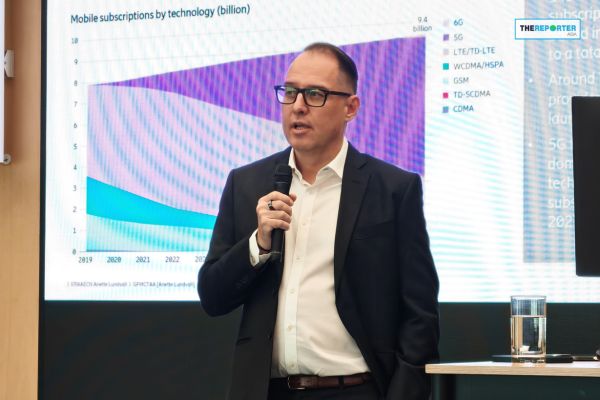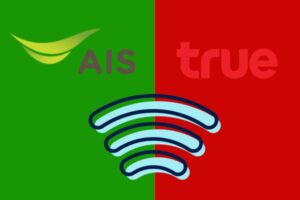Ericsson’s latest Mobility Report paints a transformative future for Thailand’s telecom industry, forecasting a dramatic surge in data consumption to 67GB per person by 2030. This data explosion intensifies the post-auction battle for supremacy between giants AIS and TRUE, who now command a combined spectrum arsenal of nearly 3000 MHz. The key to victory, Ericsson emphasizes, lies in deploying 5G Standalone and expanding Mid-band spectrum—the critical catalysts for unlocking the next wave of innovation and powering the nation’s digital economy.
Bangkok, Thailand – The global technological landscape is now unequivocally revolving around the axis of 5G, and the latest Ericsson Mobility Report (June 2025) provides a clear and compelling vision of this imminent future. The world is rapidly advancing toward an era of truly ubiquitous connectivity, with the report forecasting a staggering 6.3 billion 5G subscriptions globally by the end of this decade. This figure is more than a mere statistic; it is a leading indicator of a profound economic and societal transformation. Even more critically, traffic running on 5G networks is projected to become the very backbone of our digital world, accounting for over 80% of all mobile data traffic. This paradigm shift signals both immense opportunity and formidable challenges, particularly for dynamic and fiercely competitive markets like Thailand.
The global appetite for digital data continues its relentless growth. While the year-on-year percentage growth rate may be stabilizing, the absolute volume of data consumed is expanding exponentially. Data from the first quarter of 2025 reveals that global mobile network data traffic still increased by 19% compared to the same period last year and is expected to more than double across the forecast period to the end of 2030. This phenomenon is mirrored in the Southeast Asia and Oceania region, where Ericsson anticipates 5G subscriptions will reach 630 million, or 49% of all mobile subscriptions, by 2030. Concurrently, user behavior will intensify, with data consumption per smartphone projected to climb from 19 gigabytes per month in 2024 to 38 gigabytes per month in 2030. These figures serve as a direct call to action for all service providers, urging them to urgently fortify their network infrastructure to handle the impending “data tsunami.”
Within this context, Thailand’s situation is particularly compelling and intense. Over the past few years, 5G has proven to be a significant driver of data consumption and, consequently, a vital tool for operators in boosting Average Revenue Per User (ARPU). The Ericsson report’s specific forecast for Thailand reveals a future of hyper-connectivity, with data usage per subscription expected to soar from 35 gigabytes per month in 2025 to a remarkable 67 gigabytes per month by 2030. Overall data traffic across the nation’s networks is set to grow from 104 petabytes per day to 237 petabytes per day over the same period. This reflects the deeply embedded digital lifestyle of Thai consumers, whose demand for higher speeds, greater capacity, and flawless connectivity is virtually insatiable.
This explosive growth poses a critical business question: which operator’s network is best equipped to handle this demand, and who will emerge as the leader in this new era? The answer lies fundamentally in “spectrum,” the invaluable resource that is the lifeblood of the telecommunications business. The aftermath of the latest spectrum auction has laid bare the strategic capabilities and arsenals of each major player. Industry leader AIS now holds the largest portfolio with a total of 1460 MHz, closely followed by its formidable rival TRUE with 1350 MHz.
The possession of a diverse and comprehensive spectrum portfolio—spanning low-band for wide-area coverage, mid-band for a balanced blend of speed and reach, and high-band for surgical deployment of ultra-high speeds in dense urban areas—equips both telecom giants with the necessary tools to strategize for market dominance. This allows them to cater to increasingly complex consumer and enterprise demands. Meanwhile, National Telecom (NT), with its remaining 410 MHz post-August 2025, faces a strategic inflection point, likely needing to pivot towards niche markets or form strategic alliances to remain competitive.
However, merely possessing a large quantity of spectrum is only the beginning of the story. Mr. Anders Rian, President of Ericsson Thailand, offers a sharp and insightful perspective on the situation: “We are at a turning point where the 5G network and its ecosystem are ready to unleash a new wave of innovation. To fully realize 5G’s potential, it is crucial to accelerate the adoption of 5G Standalone (SA) and further build out the Mid-band frequency base.”
This statement from Ericsson Thailand’s leader underscores a critical truth: unlocking the ultimate capabilities of 5G requires a deep investment in its core technology, 5G Standalone (SA). Unlike its non-standalone predecessor which relies on a 4G core, SA is a pure 5G architecture from the core to the radio. This technological leap enables transformative services such as ultra-reliable low-latency communication (URLLC) and network slicing—the ability to create dedicated virtual networks with guaranteed performance for specific applications. These capabilities are essential for next-generation use cases in industry (smart factories, remote surgery, autonomous vehicles) and for consumers (cloud gaming, truly immersive AR/VR).
This must be pursued in tandem with the expansion of Mid-band spectrum, which is globally recognized as the “sweet spot” for 5G. While mid-band 5G population coverage in Europe has now surpassed 50%, it still lags behind leaders like North America (over 90% coverage) and India (95% coverage). Accelerating the deployment and utilization of mid-band spectrum in Thailand is, therefore, a strategic imperative that cannot be overlooked by policymakers and operators alike.
Looking ahead, the evolution of applications and services will place even greater strain on network infrastructure. The proliferation of devices equipped with generative AI (GenAI) and the increasing complexity of AI applications will fundamentally alter network traffic patterns. Operators must now place a much stronger emphasis on “uplink capacity” and “low latency,” as user behavior shifts from a download-heavy consumption model (watching videos) to a more symmetrical, interactive model (conversing with AI assistants, sending voice and video prompts for real-time processing). Furthermore, technologies like “Differentiated Connectivity,” which allow for the management of connection quality based on the specific needs of an application, will become key to delivering premium experiences for specialized services like personal AI agents or intelligent conversational apps. All of these advancements depend entirely on the robust foundation of a 5G SA network.
As a global 5G leader with 167 live 5G networks launched worldwide, Ericsson has declared its full commitment to supporting Thailand’s digital transformation. “Our core vision is to build a high-performance, reliable, and sustainable connectivity network to accelerate Thailand’s journey into the digital economy… We believe that strong collaboration within the ecosystem is essential to fully unlock the potential of the digital economy and society,” stated Mr. Rian.
In conclusion, the full arrival of the 5G era presents both a monumental opportunity and a significant challenge for Thailand’s telecommunications industry. The competitive war is no longer fought on the basis of subscriber numbers or price promotions alone. The new battlefield is defined by network quality, the ability to deliver innovation, and the capacity to support future-proof services. The post-auction battle has officially begun, and long-term victory will belong to the operator who can most intelligently manage their spectrum resources while strategically investing in core technologies like 5G SA and mid-band expansion. This is the only path to successfully navigating the coming data tsunami and unlocking the full, unbridled potential of Thailand’s digital economy.
“By joining forces, we are building a connected future for Thailand that is inclusive, resilient, and ready for any opportunities that lie ahead,” Mr. Anders Rian concluded.
#5G #DigitalEconomy #EricssonMobilityReport #Telecommunications #AIS #TRUE #Spectrum #DigitalTransformation #Ericsson #ThailandBusiness






